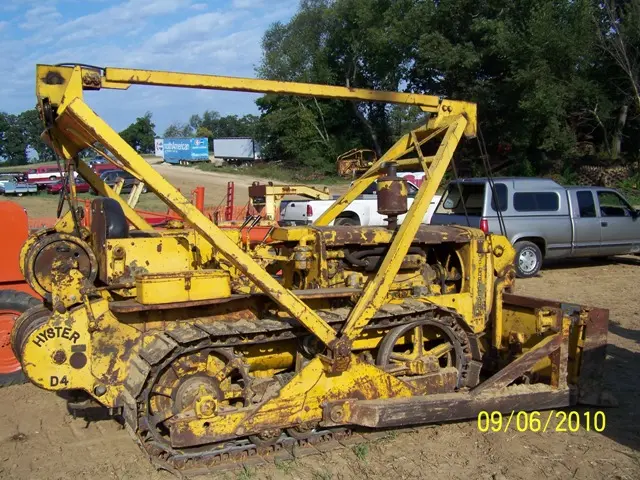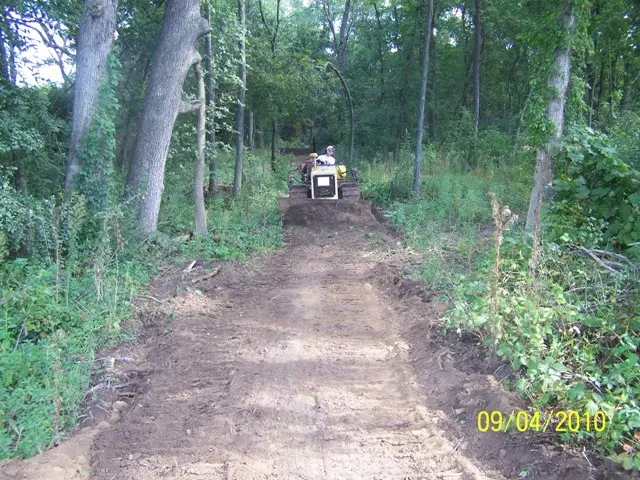One good source of information is a book titled " Moving The Earth " by H.L. Nichols. Its been around for a long time and covers many subjects... its over 2 inches thick.
You can probably borrow it from your local library, or look for one on Amazon, or e-bay.
Arborigine, your dad was basically right. Get a flat spot and just continue it where you want to go. The steepness of the hillside and the condition of the ground will have a lot to do with how it is done. The book "Moving the Earth is a good source of information. The best way is just to start and learn. Just be carefull and go slow.😖cared: If your tracks are not in ideal condition or not just "snug" enough, you may also get a lesson on RE-installing a thrown track!!:doh::frusty::mad2::censored::censored: I'm sure more good techniques and information will follow. I have'nt gotten any bad advice from these folks yet.
You have a wonderful day. Best wishes. Deas Plant.
Hi, Arborigine.
Firstly, I have to say that an angling blade without some sort of tilt adjustment is almost as useful as a breast pocket in a G-string. Most angle blades had either a screw adjustment built into the top brace on each side - the Caterpillar way on D6's and up - or some form of toothed clamp right behind where the angle arms pin to the blade - common on smaller Cats and IH dozers. But you have to have a DIFFERENT blade on yours, don't you? LOL.
It is ALWAYS easier on the machine if you can start at the top and work downhill. How-wevver, you have more control of your material when working uphill. When working downhill, you can push quite a bit more but the material tends to fall away from the blade rather than be guided by it. When working uphill, you can push less but the material goes where you push it 'cos it can't fall away from the blade.
If you want to demonstrate the above, do a cut downhill with your blade angled and then do a cut uphill with your blade angled and notice the difference. The material will move across the angled blade much quicker travelling uphill than it will travelling downhill.
If you have something vaguely resembling flat ground to start from, start your cut with your blade angled to throw the material to what will be the low side. Once you have a windrow on that low side, back up with that side track up on the windrow. This will juss natcherly tilt the other side of the blade down, giving you a bit of a lead in to start your next pass. It also helps to compact the outside edge of your road-track-trail.
If the country is not too steep, another approach is to reverse up the hill above where you want to start your road and cut downhill toward the road. When you get to where you want the road to be, quickly lift your blade and dump the material where you want the outer edge of the road to be. Do this for 3 to 6 blade widths to give yourself a berm on which you can place the outside track to help get your dozer something like level. It is better to have the machine laying in towards the hill rather than outwards towards the downslope. It is easier to cut the outside edge down than it is to build it up. You can also use the old 'windrow-on-the-outer-edge' trick to help adjust your tilt as you progress along your road.
Pretty much all sidehill cutting places more load on the uphill side steering, drive and track than it does on the low side. Be aware of this at all times. Sometimes, it may be better to back up a little and take a lighter cut a little out from where you want the finished uphill side to be to lighten the load, then go back and cut the rest away to get to your planned cut line.
Unless you hit rock or material that you can't cut, a D2 will do pretty much what a D9 will do. It just takes a little longer is all. BUT, you get more practice at operating with the smaller machine.
Just as a matter of interest, does your D2 have the small front idlers or the large ones? I don't have the respective diameter figures here but I would be surprised if Old Magnet or somebody could not come up with them. The larger front idlers make it so much easier to do finishing work with a D2 - or a D4.
Just my 0.02. Happy dozing.
Good advice, guys. I have looked up the book online, anything less that 30 years old is expensive. We actually got a local "liberry" a few years ago and they will be getting the book. After I read the newer version I will probably order an older one.
I'm not sure of my idles size yet, and have one solid and one spoked. Weird.
Thanks, Paul


I watched the fellow running this D4 leveling out unflat ground, He manouvered around on a very small patch of flat pushing the unlevel earth around in front of his straight blade. Often not moving alot of distance. In this way he could utlilize the effectiveness of his straight blade.
In the other photo, the blade on the D2 is tilted, still I drove in there to find the flatest spot to start from knowing that it would save time getting that much of the roadway done. There is a really steep cut in the roadway, but remember that this was/is going to settle with Fall rains, Winter snow and Spring rain before anyone will go back in there to finish it. Which I heard 2 weeks ago I got "volunteered" to do. 😆
drujinin,
Sometimes the volunteer/playtime all kind of merges together.... 👍
Got a couple of those myself 😊
You have a wonderful day. Best wishes. Deas Plant.
Hi, Arborigine.
I have no idea of your skill levels with earthmoving equipment so I thought it might be in order to give a rundown on the very basics of operating a dozer. Much of this also applies to other machines, particularly track and 4wd loaders, but to most other types as well to a greater or lesser degree.
Possibly the most important skill that you need to develop in operating any form of mobile plant is to be able to tune in to what your favorite rump steak is telling you about what the machine is doing and will do. In PLAIN English, this means learn to feel with your butt, the part of you that you put in the seat. When you KNOW how to feel what your machine is telling you, you can aniticipate what the machine is about to do by the subtle changes in balance, fore and aft, sideways or diagonally. This is especially true of machines that have a pivot point in their contact with the ground, such as dozers and track loaders, also to some degree excavators.
It is largely this 'FEEL' for the machine that is the difference between a GOOD operator and just an operator. There are a few other things that go into the mix too, things like being able to get the job done with minimal - read nil - damage to the machine and no unnecessary damage to the environment. Knowing HOW to plan the job is also a substantial part of the mix - knowing what you need to get the machine to do to achieve the desired end result.
I usually sum it up like this. The art of moving earth is the ability to set your blade/bucket/bowl to take the material from where it needs to be taken to where it needs to be placed in the condition that it needs to be there in with the least number of passes. To use plain language, work at keeping your cutting edge, as far as possible, where it needs to be, doing what it needs to be doing, regardless of what the rest of the machines does - within reason, like short of rolling it.
Hope this helps.
Hi, Arborigine.
I have no idea of your skill levels with earthmoving equipment so I thought it might be in order to give a rundown on the very basics of operating a dozer. Much of this also applies to other machines, particularly track and 4wd loaders, but to most other types as well to a greater or lesser degree.
Possibly the most important skill that you need to develop in operating any form of mobile plant is to be able to tune in to what your favorite rump steak is telling you about what the machine is doing and will do. In PLAIN English, this means learn to feel with your butt, the part of you that you put in the seat. When you KNOW how to feel what your machine is telling you, you can aniticipate what the machine is about to do by the subtle changes in balance, fore and aft, sideways or diagonally. This is especially true of machines that have a pivot point in their contact with the ground, such as dozers and track loaders, also to some degree excavators.
It is largely this 'FEEL' for the machine that is the difference between a GOOD operator and just an operator. There are a few other things that go into the mix too, things like being able to get the job done with minimal - read nil - damage to the machine and no unnecessary damage to the environment. Knowing HOW to plan the job is also a substantial part of the mix - knowing what you need to get the machine to do to achieve the desired end result.
I usually sum it up like this. The art of moving earth is the ability to set your blade/bucket/bowl to take the material from where it needs to be taken to where it needs to be placed in the condition that it needs to be there in with the least number of passes. To use plain language, work at keeping your cutting edge, as far as possible, where it needs to be, doing what it needs to be doing, regardless of what the rest of the machines does - within reason, like short of rolling it.
Hope this helps.
[quote="Deas Plant."]I usually sum it up like this. The art of moving earth is the ability to set your blade/bucket/bowl to take the material from where it needs to be taken to where it needs to be placed in the condition that it needs to be there in with the least number of passes. To use plain language, work at keeping your cutting edge, as far as possible, where it needs to be, doing what it needs to be doing, regardless of what the rest of the machines does - within reason, like short of rolling it.
Hope this helps.[/quote]
That is exactly what I do as a machinist on a smaller scale except the removed material is waste.
[img]http://i221.photobucket.com/albums/dd236/arborigine/MVC-023S.jpg[/img]
[img]http://i221.photobucket.com/albums/dd236/arborigine/Pictures012.jpg[/img]